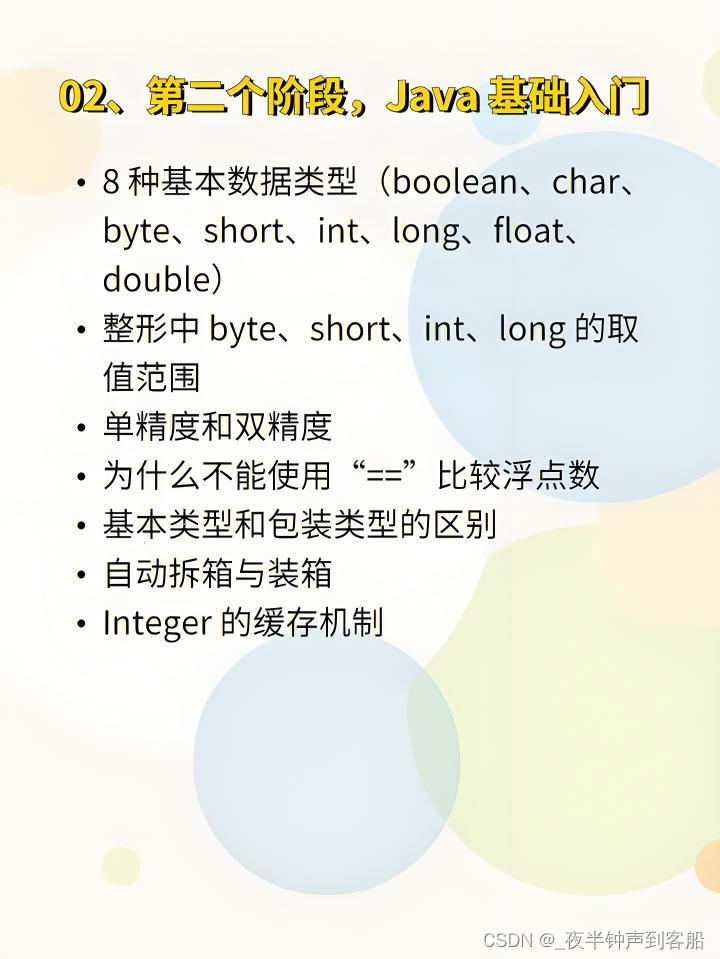学习路径:入门学习、深入学习、核心技术,
每个主题都包括很多的操作案例和实际代码示例。


a. 入门学习:
1. 基础语法:
-
变量和数据类型:
// 定义和初始化变量 int age = 25;// 不同数据类型的声明 double price = 19.99; char grade = 'A'; boolean isJavaFun = true; -
运算符:
// 算术运算符 int result = 10 + 5;// 关系运算符 boolean isEqual = (result == 15);// 逻辑运算符 boolean logicalResult = (result > 0) && (result < 20); -
控制流:
// if-else语句 int score = 75; if (score >= 60) {System.out.println("Pass"); } else {System.out.println("Fail"); }
2. 面向对象编程:
-
类和对象:
// 定义一个简单的类 public class Car {String brand;int year;void start() {System.out.println("Car is starting.");} }// 创建对象并调用方法 Car myCar = new Car(); myCar.brand = "Toyota"; myCar.year = 2022; myCar.start(); -
继承和多态:
// 继承 class Animal {void sound() {System.out.println("Animal makes a sound");} }class Dog extends Animal {void sound() {System.out.println("Dog barks");} }// 多态 Animal myAnimal = new Dog(); myAnimal.sound(); // 输出: Dog barks -
封装和抽象:
// 封装 public class Circle {private double radius;public double getRadius() {return radius;}public void setRadius(double radius) {if (radius > 0) {this.radius = radius;}} } -
如有任何问题,关注公众号职说精选后,留言即可。
3. 基本数据结构和算法:
-
数组和链表:
// 数组 int[] numbers = {1, 2, 3, 4, 5};// 链表 List<Integer> linkedList = new LinkedList<>(); linkedList.add(1); linkedList.add(2); -
基本算法:
// 冒泡排序 void bubbleSort(int[] arr) {int n = arr.length;for (int i = 0; i < n - 1; i++) {for (int j = 0; j < n - i - 1; j++) {if (arr[j] > arr[j + 1]) {int temp = arr[j];arr[j] = arr[j + 1];arr[j + 1] = temp;}}} }
4. 实践和项目:
- 小项目:
- 创建一个简单的计算器应用,支持基本的加减乘除操作。
- 算法实践:
- 尝试解决LeetCode上的简单算法问题,如两数之和、反转链表等。
b. 深入学习:
1. 集合框架:
-
List、Set、Map:
// List List<String> list = new ArrayList<>(); list.add("Java"); list.add("Python");// Set Set<Integer> set = new HashSet<>(); set.add(1); set.add(2);// Map Map<String, Integer> map = new HashMap<>(); map.put("One", 1); map.put("Two", 2); -
迭代器:
// 使用迭代器遍历List Iterator<String> iterator = list.iterator(); while (iterator.hasNext()) {System.out.println(iterator.next()); }
2. 异常处理:
-
自定义异常:
// 自定义异常类 class CustomException extends Exception {CustomException(String message) {super(message);} }// 使用自定义异常 try {throw new CustomException("This is a custom exception"); } catch (CustomException e) {System.out.println(e.getMessage()); } -
异常链:
try {// some code that may throw an exception } catch (Exception e) {throw new CustomException("An error occurred", e); }
3. 多线程编程:
-
Thread和Runnable:
// 继承Thread类 class MyThread extends Thread {public void run() {System.out.println("MyThread is running");} }// 使用Thread类 Thread thread = new MyThread(); thread.start(); -
同步和锁:
// 同步方法 class Counter {private int count = 0;public synchronized void increment() {count++;} }
4. 实践和项目:
- 小型项目:
- 创建一个简单的多线程任务调度程序,模拟任务执行。
- 并发编程:
- 学习使用
ExecutorService进行线程池管理。
- 学习使用
c. 核心技术:
1. I/O操作:
-
文件读写:
// 使用BufferedReader读取文件 try (BufferedReader reader = new BufferedReader(new FileReader("file.txt"))) {String line = reader.readLine();while (line != null) {System.out.println(line);line = reader.readLine();} } catch (IOException e) {e.printStackTrace(); } -
网络编程:
// 服务器端 ServerSocket serverSocket = new ServerSocket(8080); Socket clientSocket = serverSocket.accept(); // 处理客户端连接//客户端 Socket socket = new Socket("localhost", 8080); // 处理与服务器的连接
2. 数据库访问:
-
JDBC:
// 使用JDBC连接数据库 try (Connection connection = DriverManager.getConnection("jdbc:mysql://localhost:3306/mydatabase", "user", "password");Statement statement = connection.createStatement()) {ResultSet resultSet = statement.executeQuery("SELECT * FROM mytable");// 处理结果集 } catch (SQLException e) {e.printStackTrace(); } -
连接池:
// 使用连接池 ComboPooledDataSource dataSource = new ComboPooledDataSource(); dataSource.setJdbcUrl("jdbc:mysql://localhost:3306/mydatabase"); dataSource.setUser("user"); dataSource.setPassword("password");try (Connection connection = dataSource.getConnection();Statement statement = connection.createStatement()) {ResultSet resultSet = statement.executeQuery("SELECT * FROM mytable");// 处理结果集 } catch (SQLException e) {e.printStackTrace(); }
3. 实践和项目:
- 数据库应用:
- 创建一个简单的Java应用程序,连接数据库并执行一些基本的CRUD操作。
- 如有任何问题,关注公众号职说精选后,留言即可。


)













![[图片来源BZhan]最小生成树(Prim➕Kruskal)、最短路径(Dijkstra➕Floyd)](http://pic.xiahunao.cn/[图片来源BZhan]最小生成树(Prim➕Kruskal)、最短路径(Dijkstra➕Floyd))
![⑥【bitmap 】Redis数据类型: bitmap [使用手册]](http://pic.xiahunao.cn/⑥【bitmap 】Redis数据类型: bitmap [使用手册])
无重复字符的最长字串)
